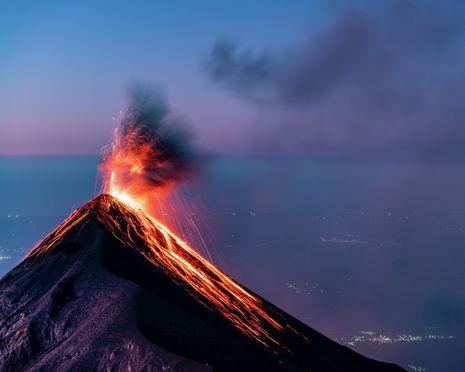Varsity Explains: why a supervolcanic eruption wouldn’t necessarily end the world
Supervolcanoes such as Yellowstone are frequent sources of fear in the media, but Bella Manfredi explains why such an eruption may not necessarily be the threat that many envisage

Science as we know it is a dynamic matter, forever expanding its parameters to facilitate newer explanations and theories. Despite this, there are still many phenomena cloaked in uncertainty. Lack of understanding is a topic that makes humans feel fearful – it is the prospect of not knowing enough about something and hence feeling afraid or ill-prepared. Articles about the prospect of a supervolcanic eruption are a common feature for many media outlets, especially online, generating clicks. Whether the information they present is correct or not, scaremongering is frequent and hysteria is generated, and this article will attempt to explain why such hysteria is often misplaced.
But first of all, what is a supervolcano? A supervolcano can be defined as a volcano that has an eruption with a Volcanic Explosivity Index (VEI) of 8. For context, VEI was devised by the scientists Stephen Self and Christopher Newhall with the aim of comparing the impacts of volcanism based on three key elements: firstly, the volume of tephra emitted; secondly, the type of eruption; and thirdly, the height of the incident eruption column. The eruption column is the cloud which extrudes from the volcano during an eruption, whilst tephra refers to volcanic material such as rock fragments. There are predicted to be around 20 supervolcanoes worldwide, spanning five of our seven continents. Some of the most supervolcanoes ones include Campi Flegrei in Italy, Taupo in New Zealand, Toba in Indonesia, and Yellowstone in the USA.
There are various types of volcanoes, and differences in the chemical properties of their magma causes different types of eruptions. The silica content of magma contributes to its explosivity, with so-called rhyolitic magma (silica content of 65-75%) being the most violent (Nelson, 2015). This higher content makes it difficult for gases to escape the magma, so instead of gently diffusing out, gases are ejected simultaneously with the rest of the volcanic material. As well as additional explosivity, the volume of tephra emitted by an eruption of this magnitude is around 1000km³. Now that the context behind these eruptions had been explained, what would the effects of an eruption be?
As mentioned earlier, there's lots of scaremongering in the media surrounding supervolcanoes – namely Yellowstone in the USA. Outlets often try to generate clicks via instilling fear in people, utilising dramatic headlines to do so. The reality is that we don’t need to be massively worried about a future eruption being imminent, especially given the severity of the current climate crisis.
“The reality is that we don’t need to be massively worried about a future eruption being imminent, especially given the severity of the current climate crisis”
Humanity has experienced large volcanic eruptions in the past, such as the eruption of Mount Toba around 73,000 years ago. Yellowstone itself has not erupted at this scale for over 640,000 years, and the next eruption could be as far as 100,000 years away. Evidence of supervolcanic eruptions is difficult to find (Daag and van Westen, 1996), so modelling potential impacts proves difficult for scientists. Such evidence is often lost too, further complicating the matter. Estimates say that Toba’s 73,000 year-ago event emitted nearly 3000km³ of magma, as well as causing a six-year volcanic winter. Periods such as this refer to the decrease in temperature due to changes to the Earth’s atmosphere, be it ash blocking out sunlight in the short term, or sulphur aerosols scattering radiation and reducing the amount that can reach the Earth’s surface in the longer term.
Despite this sounding fatal in terms of famine, researchers from Arizona State University discovered that humans in Africa may not have been as badly affected as once anticipated. The environment usually suffers at the hands of volcanic eruptions, especially as lower levels of solar radiation have implications that see photosynthesis decrease. This can cause plants to have a lower biomass and thus there is less energy and food to go around, seeing populations decline: this, however, is not mutually exclusive to supervolcanic eruptions. The likely outcome of a large-scale eruption would be that supply chains are disrupted, having consequences for larger populations that cannot support themselves. Self-sufficient countries would be less badly affected in this remit, but the copious amounts of interdependency throughout the world would see both food and other economic flows reduced. The largest economic effect would be the plummeting of the global financial markets in the face of a crisis.
“The likely outcome of a large-scale eruption would be that supply chains are disrupted, having consequences for larger populations that cannot support themselves”
Similarly, there could be a plethora of both social and economic effects of such an event. Primarily, the effects of ash would vary depending on how much is ejected: Durham University’s Richard Brown stated that 10cm of ash could collapse roofs, whilst 20cm could kill crops. However, not all pyroclastic flows lead to large amounts of ash being deposited, and the extent to which land would be ‘covered’ with ash is difficult to predict. Naturally, areas closest to a volcano would suffer the most, but the scale is difficult to quantify and is unlikely to be the same as media outlets predict.
Another social effect could be possible riots and social disorder, potentially linked to a lack of food. This happened in 1815 when Mount Tambora erupted, with estimates saying up to 200,000 people died because of famine. Securing food was an issue, hence social unrest. Depending on the scale of a hypothetical eruption, it is reasonable to say that this impact may be seen again.
This article promised to explain why a supervolcanic eruption wouldn’t be the end of the world, and it has. These effects are largely part of the worst-case scenario and rely on a very intense eruption occurring. The chances of such an event happening are minimal for thousands of years, and there are larger threats to humankind than this. Additionally, the world has rebounded from supervolcanic eruptions in the past, namely Taupo (~24,500 years ago) and Toba (~73,000 years ago). Based on this, there's good reason to suggest that we’d survive in the future.
Finally, advances in science and technology may be more protective than we realise. It may be labelled optimistic by some, but there is no way to guarantee the world’s destruction in the way that the media seem to think. The distance of key places from the initial blast zone is crucial, and the world as a whole could likely rebound from such an event. Granted, some effects could be disastrous, but by the time Yellowstone is next predicted to erupt, who knows how far science may have come. 100,000 years away is a long time, after all.
 News / Cambridge academics stand out in King’s 2026 Honours List2 January 2026
News / Cambridge academics stand out in King’s 2026 Honours List2 January 2026 Interviews / You don’t need to peak at Cambridge, says Robin Harding31 December 2025
Interviews / You don’t need to peak at Cambridge, says Robin Harding31 December 2025 Comment / What happened to men at Cambridge?31 December 2025
Comment / What happened to men at Cambridge?31 December 2025 Features / “It’s a momentary expression of rage”: reforming democracy from Cambridge4 January 2026
Features / “It’s a momentary expression of rage”: reforming democracy from Cambridge4 January 2026 News / Varsity’s biggest stories of 202531 December 2025
News / Varsity’s biggest stories of 202531 December 2025










